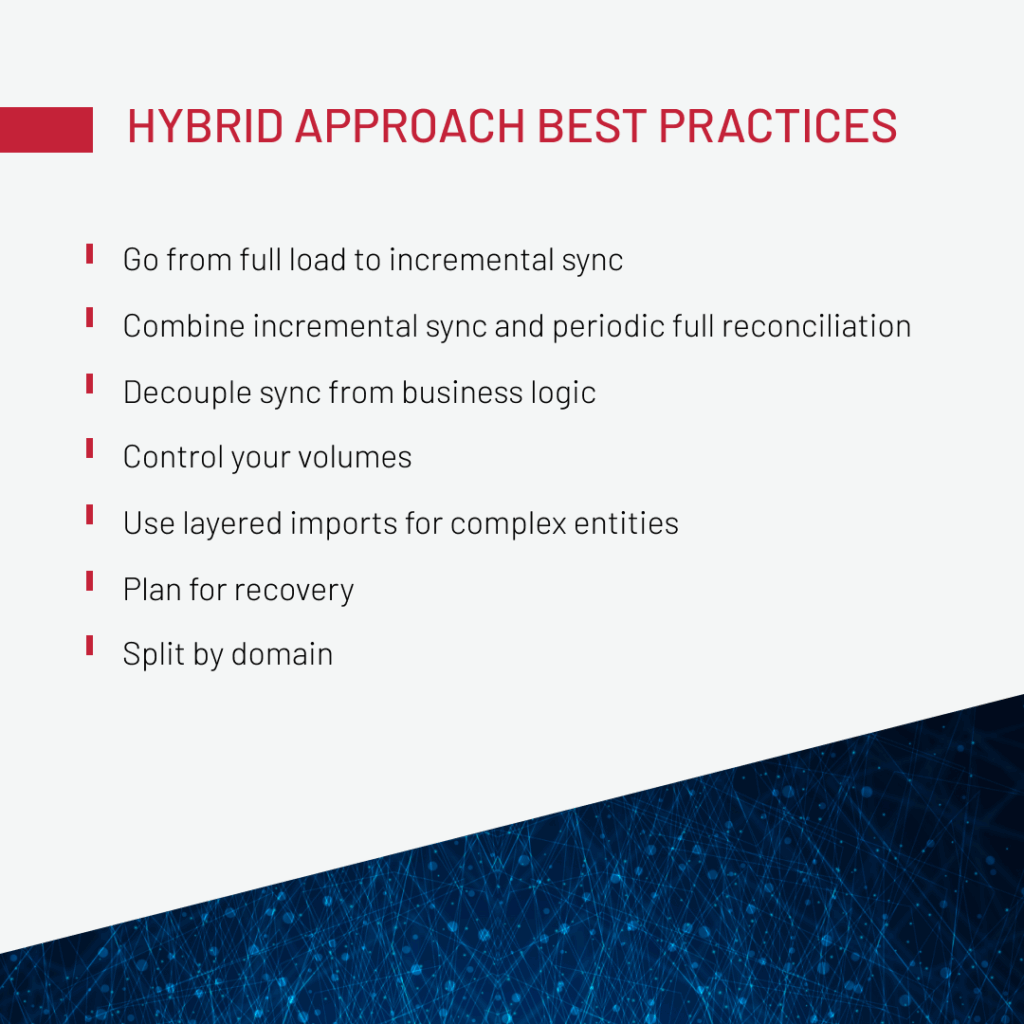Full Load vs. Incremental Load in High-Load Ecommerce: Specifics, Pitfalls, Approaches

Where does the data come from in a typical ecommerce enterprise system? Pretty much everywhere. And it needs constant syncing, updating, and loading to avoid the chaos of one delay throwing stock levels, pricing, or orders out of sync.
That’s where full and incremental data loads come into play. They’re essential for keeping systems stable and data fresh, but only if you use them right. To get the most out of your data pipelines without overloading the system, you need to know when and how to apply each approach and avoid the common pitfalls that can quietly hurt performance.
In this article, we break it all down through the lens of how Expert Soft handles data loading on real client projects. You’ll see exactly how and when to use each method to get maximum value, performance, and stability from your ecommerce platform.
Quick Tips for Busy People
These are the key takeaways from our deep dive into incremental load vs. full load strategies for high-load ecommerce.
- Use full loads deliberately. Run only during ecommerce migration or audits. Isolate and partition to reduce system strain.
- Lean on incremental sync for scale. Sync changed records only. Use watermarks and idempotent logic to avoid duplicates.
- Adopt the CDC for immediacy. Ideal for real-time stock or pricing. Requires strong infrastructure and low-latency pipelines.
- Isolate sync failures. Split by domain. A pricing issue shouldn’t block order or inventory updates.
- Decouple business logic. Use staging tables or queues to enable retries and maintain data integrity.
- Throttle large batches. Break into smaller chunks. Add checkpoints for safer failure recovery.
- Validate delta logic rigorously. Bad change detection causes silent data loss or corruption. Test edge cases carefully.
- Layer your strategy. Mix full, incremental, and CDC based on data frequency and business criticality.
Now, let’s look at how these concepts play out on the ground.
Why Is the Approach Type Critical in High-Load Ecommerce?
In high-load ecommerce, what creates complexity is the velocity at which data changes, the variety of sources it comes from, and the volatility of business rules driving it. You’re dealing with tens of thousands of SKUs, each with its price logic, inventory rules, and promotion schedules.
That’s why architects face a core contradiction:
-
1
Data must update frequently and fast:
ecommerce relies on constant syncs across storefronts, ERPs, and analytics.
-
2
Updates can’t degrade performance:
high-volume syncs must not interrupt business-critical flows or overload systems.
-
3
Delays in one area must stay contained:
a lag in inventory updates shouldn’t block order or pricing flows.
-
4
Correctness must hold under failure:
and overlaps without losing or duplicating data. These demands drive the need for a deep understanding of different data load types and their benefits for each scenario.
These demands drive the need for a deep understanding of different data load types and their benefits for each scenario.
Full vs. Incremental Data Load
In high-load ecommerce, you rarely choose one strategy over another. You should know when and how to combine full loads, incremental syncs, and CDC to match the shape, frequency, and criticality of your data. Here’s how these approaches differ and when each one actually makes sense.
Full (bulk) load
This is the most straightforward and reliable approach: reloading the entire dataset to ensure consistency across systems. It’s often used at the start of a project, when data needs to be brought in from scratch or completely refreshed. For example, when launching an ecommerce platform in a new region, we pulled over 70,000 customer records from an external CRM to populate the system.
While the approach guarantees full consistency and is relatively easy to implement, a full load is resource-intensive and risky. If the sync isn’t properly isolated or timed, there’s a risk of overwriting changes made during the load process. For example, if a full update takes several hours and new data is entered in parallel, those changes may be lost when older values from the load overwrite them.
Implementation specifics:
-
Watch for schema drift
Source schemas can evolve over time. If your pipeline expects one structure but receives another, it may fail or corrupt data.
-
Use partitioning to speed up loads
Parallelize the process by dividing data by SKU, date, or category to reduce total load time.
-
Time loads carefully
If a full load takes several hours and new entries are added in that window, they may be overwritten unless properly handled.
-
Prevent mid-load interference
Ensure no other processes modify the source or target data during the load. Overlapping writes or reads can cause conflicts or data loss.
Incremental load
So, what is incremental load? Incremental load syncs only what has changed, such as new, modified, or deleted records, since the last successful update.
In one of Expert Soft’s projects, promo imports involving up to 60,000 SKUs were originally handled via Hot Folder full loads. The process was slow and unstable. Switching to a delta-based incremental load, combined with Redis-backed queuing and recovery, reduced processing time from minutes to seconds.
Incremental loading is light, fast, and reduces strain on both source and target systems. But it comes with its traps. You need an exact mechanism for detecting changes. Miss a record? It’s lost. Double-count one? You get duplicates.
Implementation specifics:
-
Only changed records are loaded
The system syncs new, updated, or deleted records since the last successful load, not the entire dataset.
-
Watch for incomplete deltas
If the watermark is lost or incorrect, partial updates can break downstream systems, so delta accuracy must be tightly controlled.
-
Ensure idempotent writes
The system must handle retries safely. If the same record is processed again, it shouldn’t be duplicated or conflict with existing data.
-
Store a reliable watermark
Use timestamps or unique change IDs to track the last synced record. Without this, you risk missing changes or duplicating data.
CDC (change data capture) as a step to real-time synchronization
While both incremental sync and CDC focus on syncing only changes, CDC operates at a lower level, directly from transaction logs, and delivers near real-time propagation, unlike scheduled or polled deltas. This makes it ideal for scenarios where even a few minutes of delay are unacceptable: think inventory levels, pricing updates, or behavioral analytics.
When working with a financial intelligence platform, we initially relied on daily batch syncs to move metrics from MySQL to MongoDB. The delays led to outdated insights and missing data. Replacing this with a CDC pipeline powered by Amazon DMS and Kafka allowed us to stream changes in real time, keeping data accurate and eliminating the need for full reloads.
Implementation specifics:
-
Built on database transaction logs
Captures all inserts, updates, and deletes directly from the source.
-
Not universally supported
Some databases or SaaS systems don’t expose low-level change logs, limiting CDC applicability.
-
Requires advanced infrastructure
Typical stacks include Kafka, Debezium, LogMiner, or Amazon DMS. Setup and maintenance require specialized skills.
-
Microbatches vs. Streaming
CDC events can be delivered in microbatches when the system loads data in small batches, e.g., every 5 minutes, which is simpler and easier to manage, or as continuous streaming when ultra-low latency is critical.
Let’s compare
The table below compares full load vs. incremental load (and CDC) across key dimensions to provide better visibility.
| Characteristic | Full Load | Incremental / CDC |
| Use Case | Used for initialization, migration, or full data refreshes when complete consistency is needed and no parallel updates are expected. | Designed for continuous or near-real-time sync where data changes frequently and systems must stay up to date without full reloads. |
| Speed | Slower due to the volume: the more data, the longer it takes. Even optimized, a full reload can take hours. | Much faster since only changes are processed. Syncs can complete in seconds if the volume of changes is low. |
| System Load | High system load during execution, especially if the dataset is large. Risks include performance hits and potential conflicts with other processes. | Controlled and lighter. Less impact on system performance since only deltas are processed. CDC adds streaming overhead but scales well with infrastructure. |
| Implementation Effort | Easier to implement: no need to track change logic. However, requires tight coordination to avoid overwriting active records. | Requires additional components: watermarking, change detection, idempotency, retries. CDC adds further complexity with log listeners and streaming layers. |
| Error Recovery | Harder to recover from failures: all-or-nothing behavior. Failed loads often require restarting from scratch. | Easier to isolate and retry specific failures using offsets, queues, or checkpoints. CDC pipelines support replayability out of the box. |
| Data Freshness | Low between syncs. Data may be hours or days out of date, depending on load frequency. | High. Changes are reflected quickly, sometimes instantly with, CDC streaming. Enables near real-time system behavior. |
In practice, few systems rely on just one approach.
Full and Incremental Load: What’s in Real Life?
Full, incremental, and CDC loads each serve a different role, and in real-world systems, they’re almost always combined in a hybrid model: full loads handle initial and periodic refreshes (e.g., daily for consistency), incremental loads capture operational changes between those cycles, and CDC streams critical events where minimal latency and precision are essential.
Talk to our engineers at Expert Soft. We’ve helped global retailers streamline complex data pipelines with layered sync logic, advanced failover, and zero-downtime rollouts.
Let’s talkFor example, in high-load retail systems, you can combine all three methods in the following way:
- Full load runs nightly to refresh the entire product catalog: SKUs, descriptions, media, and reset any drift.
- Incremental syncs push regular updates every 10–15 minutes throughout the day for price changes, stock levels, or category tweaks.
- CDC handles critical, time-sensitive events in real time, like flash sale price drops or inventory hitting zero, where delays aren’t acceptable.
This kind of layered sync logic gives you control. You get consistency from full loads, efficiency from incremental updates, and immediacy from CDC. And just as important: you get failover flexibility. If something breaks mid-sync, the system can catch up using offsets, watermarks, or retries without corrupting downstream data.
Hybrid Approach Best Practices
There’s no single sync strategy that fits every ecommerce use case. Over time, we’ve developed a set of field-tested practices that keep data pipelines clean, resilient, and scalable even under constant change.

From full load to incremental sync
For migrations, go-lives, or market expansions, the cleanest path starts with a full load. Bring in your base: products, customers, orders — everything. Once the system is stable, switch to incremental sync using updatedAt, versioning, or CDC.
We applied this exact sequence during a launch for a multi-region retailer. After a full import, the system switched to incremental sync well before redirecting live traffic. The result: no service interruptions, no data gaps.
Incremental sync with periodic full reconciliation
This approach is useful when desyncs occur due to system failures, lost events, or business logic errors. Scheduled full reconciliations help restore consistency without disrupting ongoing updates. That’s why in long-lived systems, it’s smart to combine high-frequency incremental updates (e.g., every 5–15 minutes) with scheduled full reconciliations.
Daily or weekly full reloads of critical entities, like inventory or pricing, serve as a data integrity reset. If you’re syncing thousands of changes per hour, this pattern gives you both responsiveness and reliability.
Decouple sync from business logic
Always keep data loading separate from business rules. Use staging tables, message queues, and ETL orchestrators to preprocess and validate data before it hits production. This lets you run dry-runs, apply transformations, and roll back cleanly if something goes wrong.
Decoupling also future-proofs your system, letting you change or test logic without disrupting the sync process.
Control your volumes
High load means high risk, especially if you’re pushing huge batches without limits. Cap the number of records per sync job. Partition loads by date, ID range, or SKU. Introduce short pauses between batches if needed to avoid overloading the source or destination system.
Breaking data into smaller chunks helps prevent timeouts, deadlocks, and locks, reducing load on both source and target systems and improving overall stability under high traffic. Limiting batch size and keeping the load consistent is more effective than pushing large volumes at once.
Use layered imports for complex entities
For structured data like promotions, bundles, or localized price grids, go layered. Load everything into a draft state, validate it, and only then activate the record. That atomic switch avoids issues where part of the data is live while the rest is still syncing.
Layered importing gives you confidence that once data goes live, it’s complete and won’t break anything downstream.
Plan for recovery
Things break. What matters is how you recover. Store offsets or watermarks so the system knows where to resume. Log every sync step. Use checksums to detect corruption or silent failures. This lets you retry with precision.
Split by domain
Don’t lump everything into one monolithic sync process. Orders, products, prices, and customers have different update frequencies, criticalities, and failure modes.
By splitting pipelines by domain, you isolate risk. A failure in price sync doesn’t delay orders. An inventory mismatch doesn’t block customer updates. This separation is what turns sync pipelines from fragile to fault-tolerant.
These best practices are how you avoid broken imports during flash sales, prevent price mismatches across regions, and keep high-frequency sync jobs from colliding. If you’re scaling across markets, onboarding new catalogs, or running hourly updates across multiple domains, these patterns turn fragile pipelines into reliable infrastructure.
To Sum Up
Choosing the right data load strategy starts with three key questions:
- What changes?
- How fast does it need to be reflected downstream?
- What happens if it’s delayed?
Your answers will shape the architecture. Full loads ensure consistency for large, slow-changing datasets. Incremental syncs keep high-churn data up to date without overwhelming systems. CDC delivers real-time accuracy where every second counts, but comes with higher complexity.
In high-load ecommerce, a layered approach works best. We at Expert Soft design pipelines around data volatility, sync frequency, and fault tolerance, creating the most efficient approach according to your system specifics and business needs. If your current setup struggles to keep up or you want to future-proof it, we’re always open to a conversation.
FAQ
-
Why does the choice of data-load strategy matter for ecommerce?
Stale or broken data leads to overselling out-of-stock items, incorrect pricing during promotions, delayed order updates, and mismatched inventory across channels. All these can damage customer trust, increase support costs, and reduce revenue in high-load ecommerce environments.
-
What is the best ETL incremental load strategy for high-load ecommerce systems?
The most effective ETL incremental load strategy combines delta-based syncs with scheduled full reconciliations. This minimizes system load, ensures timely updates, and enables recovery from failures, dropped events, or logic errors in high-frequency ecommerce environments.
-
What is the difference between full load and incremental load?
Full load reprocesses the entire dataset on each run, consuming more time and resources. Incremental load transfers only new or modified records, reducing system impact, improving sync speed, and lowering the risk of overwriting recent updates in high-load environments.
-
How hard is CDC to implement compared with classic ETL?
CDC is harder to implement than traditional incremental ETL. It requires log-based change tracking, tools like Kafka or Debezium, strict schema handling, and resilient streaming pipelines, but it’s essential when low-latency updates and event-level accuracy are business-critical.
-
Will infrastructure costs go up?
Infrastructure costs increase mainly with real-time streaming setups like CDC, which require persistent queues, log processing, and scaling. For typical ecommerce workflows, micro-batching and delta syncs are more cost-efficient and usually sufficient for maintaining data freshness and accuracy. Explore the ways in which you can reduce infrastructure costs.

Andreas Kozachenko, Head of Technology Strategy and Solutions at Expert Soft, specializes in high-load ecommerce architectures. Relying on his expertise, he ensures deep insights into efficient data load strategies, avoiding common pitfalls in complex enterprise environments.
New articles

See more

See more

See more

See more

See more
